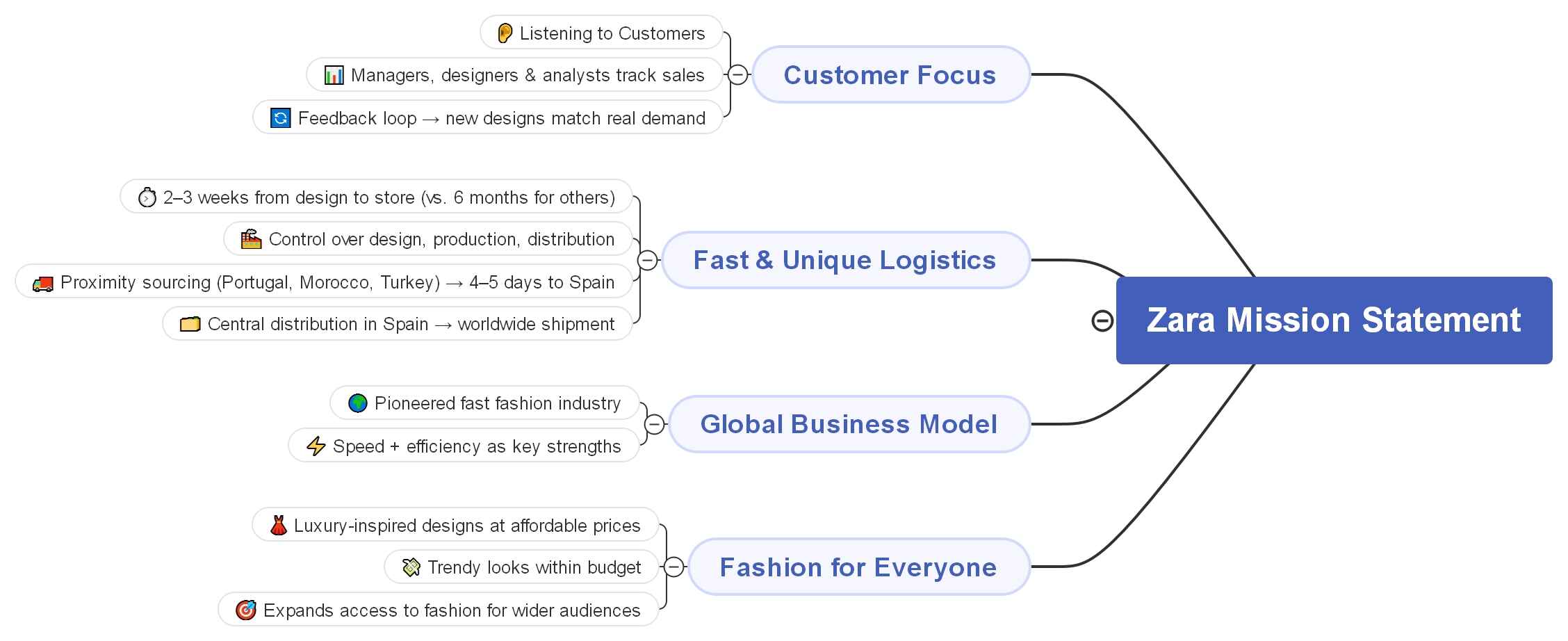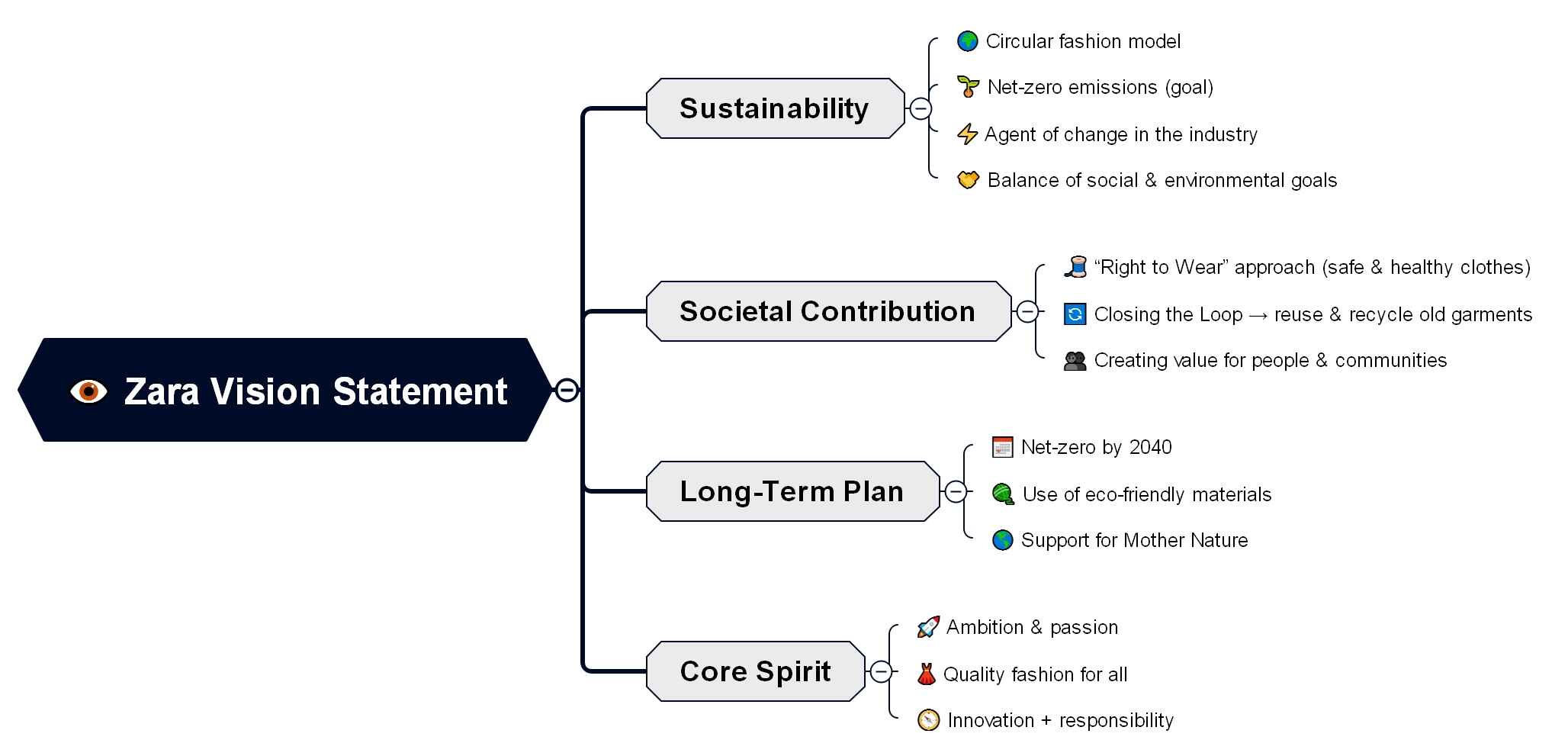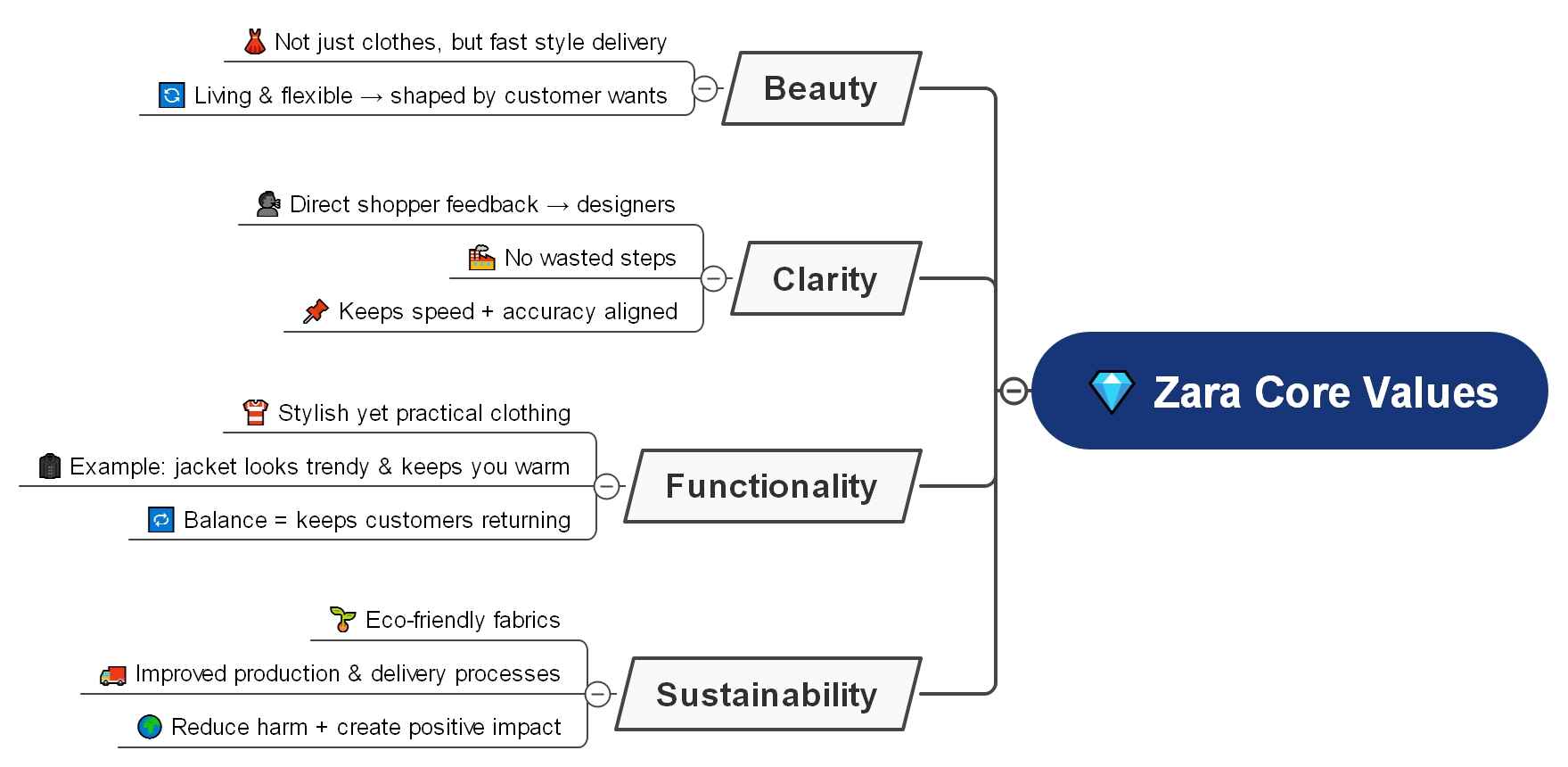Zara’s mission and vision statement analysis shows how a small shop in Spain grew into a global fashion giant, making €28 billion a year.
Since opening its first store in A Coruña in 1975, Zara has expanded to 98 countries with an online presence in 214 markets.
The secret behind this growth is speed. While most fashion retailers take months to launch new collections, Zara can go from design to store in just two weeks. That ability to move fast keeps it fresh, relevant, and always connected to what shoppers want.
In this guide, we’ll look at how Zara’s mission and vision have guided its rise, what they reveal about the brand’s purpose today, and the lessons they offer for building long-term success in a fast-changing industry.
In this article
- Overview of Zara
- Zara's History
- Understanding Zara's Mission and Vision Statement in Depth
- Zara Mission Statement Analysis
- Zara Vision Statement
- What Are Zara's Core Values?
- How to make a Mission and Vision Analysis for a Company?
- How to Effectively Analyze Mission and Vision Statements?
- FAQs
- Conclusion
Zara's mission and vision statement analysis shows how a small shop in Spain grew into a global fashion giant, making €28 billion a year.
Since opening its first store in A Coruña in 1975, Zara has expanded to 98 countries with an online presence in 214 markets.
The secret behind this growth is speed. While most fashion retailers take months to launch new collections, Zara can go from design to store in just two weeks. That ability to move fast keeps it fresh, relevant, and always connected to what shoppers want.
In this guide, we'll look at how Zara's mission and vision have guided its rise, what they reveal about the brand's purpose today, and the lessons they offer for building long-term success in a fast-changing industry.
Overview of Zara
The following table explains what makes Zara so different:
| Aspect | Information |
| Founded | 1975 in Galicia, Spain (as Hennes by Amancio Ortega Gaona and Rosalía Mera Goyenechea) |
| Headquarters | Arteixo, Spain |
| CEO | Óscar García Maceiras (CEO of Inditex, parent company of Zara, since December 2021) |
| Annual Revenue | €38.6 billion |
| Key Products | Fast fashion apparel |
| Market Cap | €164.310 billion (Inditex) |
| Latest Growth | 7.5% YoY growth in Q1 2023 |
| Official Sites | zara.com inditext.com |
| Official PDF | Inditex Annual Accounts Report 2024 |
Zara's History
Zara's story began in 1963 in A Coruña, Spain, where its founder, Amancio Ortega, grew up. Ortega first established a garment production company called Confecciones GOA. Soon after, his wife began designing lingerie and quilted robes, which led the couple to open their first Zara store in 1975.
The brand's name was originally intended to be "Zorba," after the film Zorba the Greek. However, since a nearby bar already carried that name, they adjusted it to "Zara."
Zara expanded beyond Spain in 1988, opening its first international store in Porto, Portugal, just a short distance from A Coruña. The following year, in 1989, the company launched its first U.S. location on Lexington Avenue in New York City.
Today, Amancio Ortega oversees Inditex, the global retail group that owns Zara along with other popular brands such as Pull&Bear, Bershka, and Stradivarius.
Understanding Zara's Mission and Vision Statement in Depth
Zara's journey from a small shop in Spain to a global fashion leader is built on its mission, vision, and values.
These ideas are simple to understand, but they guide how the company designs clothes, makes them, and brings them to stores. Looking at them helps explain how Zara grew so quickly while staying true to what it stands for.
Zara Mission Statement Analysis
Zara's mission statement is:
"To give customers what they want, and get it to them faster than anyone else."
From this statement, you can see the core of Zara's strategy and the reason for its global success. Here's the breakdown:
"Give Customers What They Want"
Most fashion houses in Paris or Milan release collections months in advance, shaping trends on their own terms. Zara does the opposite.
Store managers and analysts pay close attention to what shoppers actually buy and what they ask for. That information flows directly to designers, who adjust upcoming pieces based on real-time customer demand.
"Get It to Them Faster Than Anyone Else"
Speed is what sets Zara apart. If a style gains traction among young shoppers, like cargo pants or camo prints, Zara can have it designed, produced, and stocked in stores within weeks.
The secret lies in a shorter supply chain and "proximity sourcing." Instead of depending only on factories in Asia, Zara produces much of its apparel in nearby countries like Portugal, Morocco, and Turkey.
Items reach distribution hubs in Spain within days, then ship out to stores worldwide on a twice-weekly schedule.
Zara Vision Statement
A vision statement shows the future goals of a company. While the mission explains what Zara does today, the vision points to its long-term direction. Zara sums it up as:
"To contribute to the sustainable development of society and that of the environment with which we interact."
This vision shows Zara's goal of being more than a fast-fashion brand. It highlights a focus on protecting the planet, supporting people, and building a business model that is both responsible and lasting.
Sustainability
Zara's parent company, Inditex, says it is driven by an "ambition and passion to create quality fashion for all" while also moving toward a circular model and net-zero emissions.
The company calls itself an "agent of change" in fashion, aiming to combine social and environmental goals under one idea of sustainability.
- By 2025, Zara plans to use 100% sustainable cotton and linen, and 100% recycled polyester.
- By 2023, it committed to run on 80% renewable energy and to remove single-use plastics.
- It also pledged that all stores, offices, and logistics hubs will send zero waste to landfills.
Societal Contribution
Inditex also focuses on people and communities. Its "Right to Wear" approach is about responsibly making safe, healthy clothes.
Through programs like Closing the Loop, Zara collects old garments so they can be reused or recycled instead of thrown away. This shows the brand's effort to create value not just for business, but also for society.
Long-Term Plan
Inditex has a clear long-term target: to reach net-zero emissions by 2040.
To do this, it is cutting down greenhouse gases, using more eco-friendly materials, and redesigning its supply chain. Efforts like the Join Life collection and the partnership with Circ to create the first clothes from poly-cotton waste are early steps toward this goal.
What Are Zara's Core Values?
Zara builds its business on four core values: Beauty, Clarity, Functionality, and Sustainability. Each one connects directly to how the brand designs products, runs its supply chain, and serves customers.
Beauty
Zara defines beauty by creating clothes that are always stylish and up to date. The company designs over 40,000 pieces a year but produces only about 12,000, carefully choosing the ones that stand out. This way, shoppers see only the most appealing styles in stores.
Clarity
Clarity means having a clear goal: give customers what they want, faster than anyone else. This focus guides everything, from how stores are organized to how quickly new collections arrive, so the shopping experience stays direct and consistent.
Functionality
Zara makes fashion practical by keeping its supply chain extremely fast. New designs reach stores in about two weeks, while most competitors take 10 to 14 weeks. This speed keeps Zara's clothes relevant and available exactly when shoppers want them.
Sustainibility
Sustainability is now central to Zara's strategy. In 2024, 73% of the fibres it used were lower-impact, with 39% made from recycled materials. Its Join Life collection focuses on eco-friendly fabrics like organic cotton and recycled polyester, while parent company Inditex has committed to reaching net-zero emissions by 2040.
How to make a Mission and Vision Analysis for a Company?
A mission and vision analysis helps explain what a company does today and where it wants to go in the future. Here's a clear way to do it step by step.
Collect the Official Statements
The first step is to find the company's mission and vision statements. These are the foundation of the analysis.
- A mission statement tells what the company does now, who it serves, and what it offers.
- A vision statement shows where the company wants to be in the future and what it hopes to achieve.
You can usually find both on the company's website, in annual reports, or in press releases. Tip: Always use official sources so your analysis is accurate.
Break Down the Mission
Look closely at the mission statement. Notice the action words and see what the company is focusing on: customers, products, services, or values.
Then connect it to real actions the company takes. For example, Zara's mission to give customers what they want is shown through its fast response to trends.
Break Down the Vision
The vision shows long-term goals. Read it carefully to see if it talks about growth, innovation, or sustainability. Then check if the company is taking steps that match the vision, such as launching eco-friendly programs or setting future targets.
Connect Mission and Vision
An effective analysis explains how the mission supports the vision. The mission is about today, and the vision is about tomorrow. For example, Zara's mission to deliver fashion quickly links to its vision of moving fashion forward with innovation and responsibility.
Add Core Values
Many companies also list their core values. These are guiding principles that connect the mission and vision. Show how these values influence the company's actions and goals.
Give a Balanced View
A strong analysis looks at both sides. Show where the company is doing well and where it may fall short. For example, Zara's fast supply chain supports its mission, but its fast-fashion model can make it harder to fully meet its vision of sustainability.
Use a Professional Mission and Vision Statement Analysis Maker
Making a visual mission and vision statement is time-consuming if you don't have the right software. There is a lot of information to sort that may get confusing to put everything in order.
A tool like EdrawMind helps by giving you simple templates to organize your ideas. You can also turn your work into clear visuals or mind maps, which makes it easier to understand and share.
Steps to Make a Mission and Vision Statement Analysis
Follow these steps to download the tool, set it up, and use it to build a complete mission and vision statement analysis:
Step 1: Download & Login EdrawMind
Download and install Wondershare EdrawMind. Or you can also use EdrawMind online on your browser.
Log in with any of your socials, or create a free Wondershare account.
Launch the application and click Create, followed by Blank Mindmap.

Step 2: Change Layout
In a new file, head to the Map tab on the sidebar.
Under the Layout section, change your layout, according to your requirement.

Step 3: Edit Mind Map Blocks
Select the block you want to edit.
Once selected, you can either change the block style.
Change text by typing after clicking the block.
To change its appearance, use the menu that appears.

Step 4: Add More Topics
Select the block under which you want more topics.
Now either press Enter to add a sister block, or press Ctrl+Enter to add a sub block.
You can also use the Topics and Sub Topics options from the Start Menu at the top.

Step 5: Change the Style of your Mind Map
Select the topic or topics you want to edit.
Head to the Style Section from the sidebar.
Change the box shape, thickness, text and color with a single click.

Step 6: Export your Mind Map
Head to the File option in the top-right corner.
Choose the Export option.
Select the format to save as PDF, PPT, Word, Excel, or PNG, and more
Give it a name and also specify the location where you want to export on your computer.
Finally hit Export.

How to Effectively Analyze Mission and Vision Statements?
Clear mission and vision statements improve performance. Research shows that employees in mission-driven companies are 54% more likely to stay longer and 30% more likely to perform better than their peers. Use these points to evaluate statements effectively:
Keep It Simple
A statement should be short and easy to remember. Simple wording makes it easier for employees to understand and align with company goals.
Be Specific
Strong vision statements answer three questions:
- What does the organization do?
- Who does it serve?
- What change does it aim to create?
Vague statements don't provide direction. Specific ones help guide strategy and make the company's purpose easy to understand.
Make It Relevant
A statement should reflect the company's culture, industry, and daily operations. If it doesn't connect to reality, it won't guide decisions or inspire people.
Offer Insight
An analysis should point out what works and what doesn't. Highlight strengths, gaps, and opportunities to improve. Good statements are practical for today and ambitious about the future.
Check for Longevity
A mission defines what the company does today, while a vision describes the future it wants to create. Both should stay relevant as the business expands and evolves.
FAQs
FAQ
-
How does Zara's proximity sourcing strategy work?
Zara's proximity sourcing strategy works by producing a large share of its clothing in nearby countries like Portugal, Morocco, and Turkey. This shortens delivery times, lowers transport costs, and helps new designs reach stores quickly. -
What does the "Right to Wear" programme mean for Zara?
Zara's "Right to Wear" programme works by focusing on social responsibility. It ensures clothes are made in safe, healthy, and responsible ways, while also encouraging recycling through garment collection initiatives. -
Why is Zara's mission written as a simple action?
Zara's mission is written as a simple action to show clarity and focus. "Give customers what they want, and get it to them faster" highlights direct action over vague promises, reflecting Zara's emphasis on speed and customer needs.
Conclusion
For businesses and students, analyzing Zara's mission and vision is a good example of how short, simple statements can guide a whole strategy. It shows that when a company sets simple goals and follows them with action, it can grow fast and shape its industry.
If you want to do a similar analysis for another company, EdrawMind can help. It gives you ready templates to organize ideas, making your work easier to understand and share.










